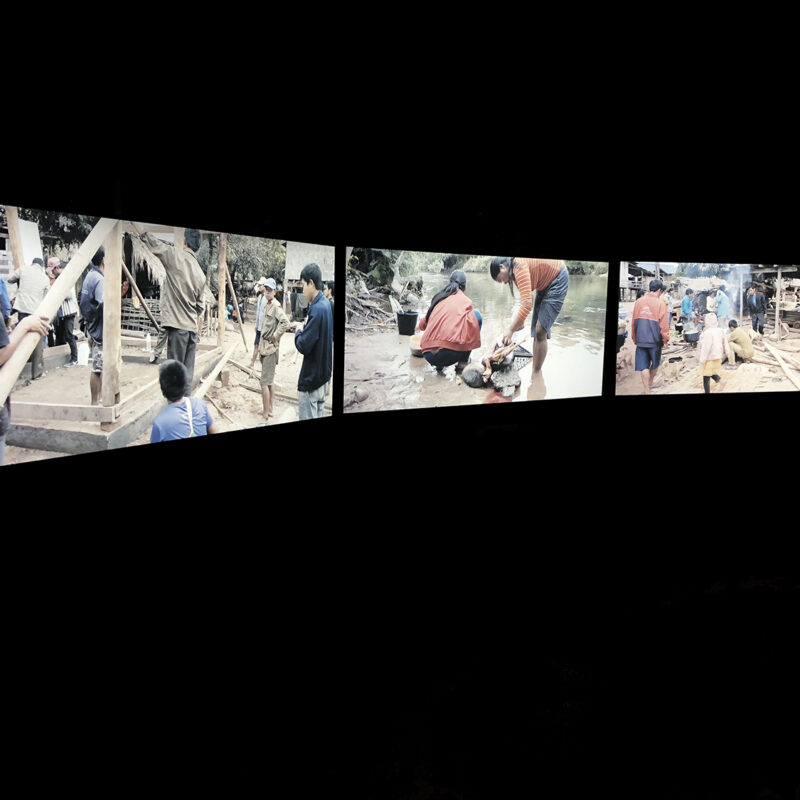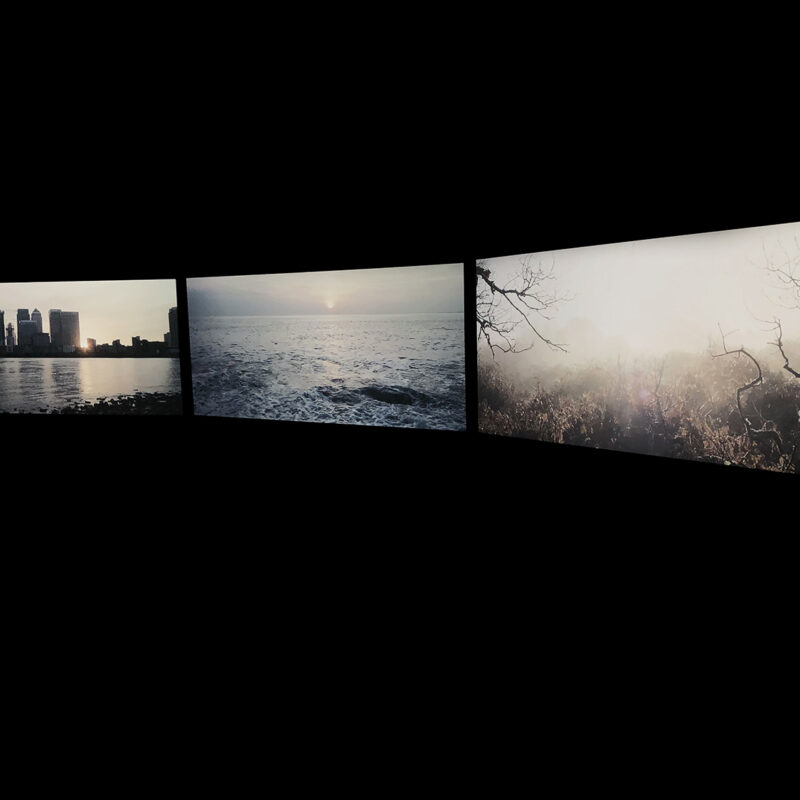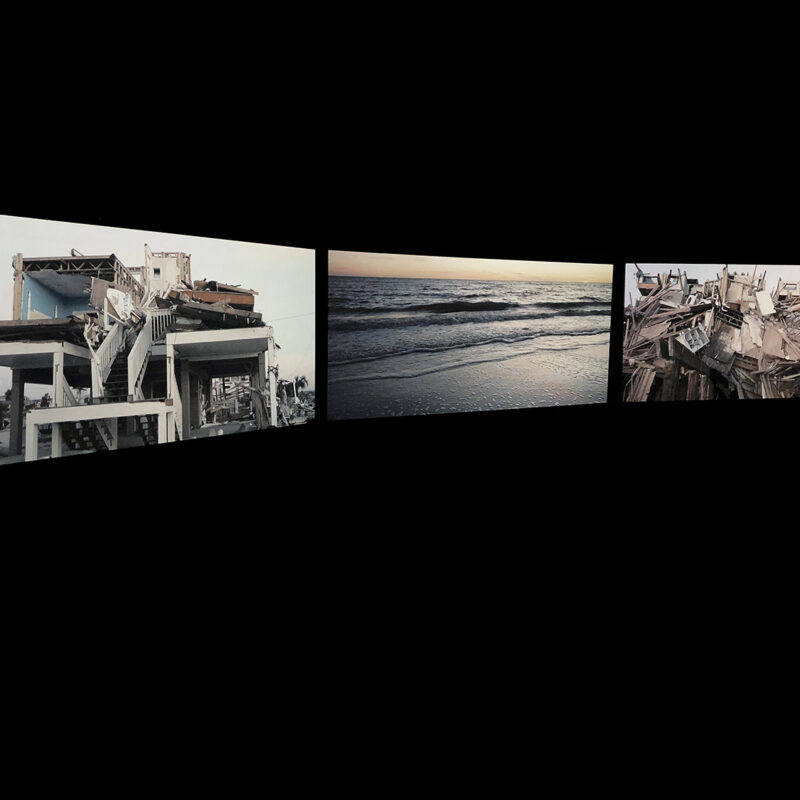Lena Dobrowolska and Teo Ormond-Skeaping, Future Scenarios
Place:
Tytano
ul. Dolnych Młynów 10
Exhibition open:
3.07. - 19.07.2020
Thu-Fri 3 pm-7 pm
Sat-Sun 11 am-7 pm
Tickets:
Free admission
In their film installation Future Scenarios, Lena Dobrowolska and Teo Ormond-Skeaping present a loose imagining of the next eighty-one years on Earth. Through four sets of speculative events that unfold along multiple pathways to the future, they imagine both deteriorating and improving climatic scenarios. The speculative events were conceived in response to Shell Energy’s ‘New Lens on the Future: Mountains and Oceans’ scenario, and the United Nations Framework Convention on Climate Change’s Representative Concentration Pathways (RCP) projections of levels of greenhouse gas emissions, and resultant global temperature-rise estimates ranging from 1.5°C to 6°C by 2100. By presenting a coloured dot instead of a defined temperature marker, Dobrowolska and Ormond-Skeaping encourage the viewer to imagine what the future may hold, as they subjectively gauge the ramifications of temperature increase, represented by the four dots’ shift from yellow to dark red.
Using their observational documentary footage as ‘Anthroposcenery’ of the future, Dobrowolska and Ormond-Skeaping explore how conjectural scenarios can be considered memories of the future, for when we envision the future, we use the same part of our brains as when recalling the past. As Shell’s scenario team wrote, ‘Thinking about the future is limited when we use past precedents to imagine it, but one way of challenging ourselves to imagine different scenarios is by becoming aware of, and understanding, different and multiple perspectives.’
By working with three screens, Dobrowolska and Ormond-Skeaping are able to present parallel perspectives on events that unfold along multiple scenario pathways. In this way, they frame the future as unsettled, through lenses that acknowledge the powerful agency of the unknown protagonist behind the camera, to whom these memories of the future possibly belong. Imperfectly retaining the footsteps of the camera operator, the stabilised camera acts as the point of view of an unknown persona, who spends time with people engaged in resilience, adaptation, and consumption activities that are related to migration, food, water, shelter, leisure, and work as their daily lives are impacted by climate change.
The embodied camera is complicit, a cool and distant observer that plays the role of someone who is responsible—both for the acceleration of climate change and for developing strategies to mitigate its effects. Although the camera is present to disrupt, it is also there to learn from those who are the most vulnerable and yet the most resilient, too. The camera is there to draw attention to itself and how it perceives others; how it reveals power relationships; how it inspires performances; and how its presence leads to the generation of further narratives and scenarios. Sometimes the camera is welcomed. At other times it is regarded as an intruder. In certain situations, the camera itself appears to be vulnerable.
The foregrounding of the camera’s presence is intended to emphasise the use of different lenses, or frameworks, in research, journalism, and documentary. Oftentimes these frameworks influence the way we interact with the world, and, without us being conscious of it, shape how we imagine our future. Although these lenses are not physically represented by, for example, a change in focal length, Dobrowolska and Ormond-Skeaping refer to these lenses via a colour-coding of research frameworks: a climate-justice framework, a neo-Malthusian framework, a technocratic framework. The artists use green for a future of climate justice and solidarity; red for a neo-Malthusian future in which drastic measures are employed to rein in overpopulation; and blue for a technocratic future, full of techno-fixes like geoengineering, in which populations are subjected to authoritarian governance.
Lena Dobrowolska and Teo Ormond-Skeaping are an artist duo working with a combination of media, including documentary photography, artists’ films, virtual reality, and installation. Their practice is research-led. Since 2012, Dobrowolska and Ormond-Skeaping have been working on projects concerned with climate change and the Anthropocene, or, to use the artists’ preferred term, the Capitalocene.
Their works document human vulnerability to, and responsibility for, climate change, as well as resilience and adaptation efforts, through an exploration of poverty, development, and environmental catastrophe, all as a means of envisioning speculative scenarios of climate change–impacted futures. In their ongoing work, they examine the ethics and methodologies of documentary representation with specific case studies relating to climate change, development, environmental degradation, human rights, and geopolitics.
In 2016, Dobrowolska and Ormond-Skeaping were awarded the ‘Culture and Climate Change’ grant and research residency, a joint effort of the University of Sheffield and the Open University, supported by the Jerwood Charitable Foundation and the Ashden Trust. They were the recipients of the 2019 Coalition for Art and Sustainable Development (COAL) Art and Environment Prize (Climate, Disaster and Displacement). Recent exhibitions of Future Scenarios include, in 2019, at the 26th Noorderlicht International Photography Festival in Groningen, Ci.Clo Bienal Fotografia do Porto, and Kunst Haus Wien: Museum Hundertwasser; and, in 2018, at Unseen Amsterdam and Fotofestiwal Lodz. Feedback Loops, an earlier project, was exhibited at venues including the Grey House Foundation in Krakow (2016), Miejsce przy Miejscu Gallery in Wrocław (2015), and Prague Photo Festival (2014).
.
IMPORTANT INFORMATION! Due to sanitary restrictions max 50 people are allowed to stay in the exhibition space.
.
.
.





